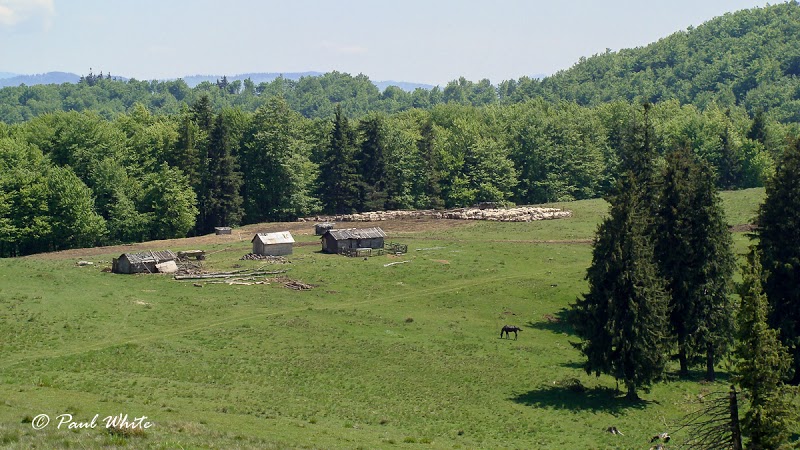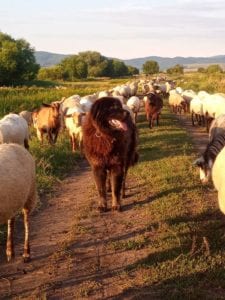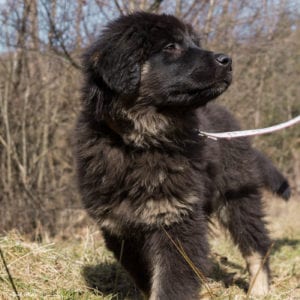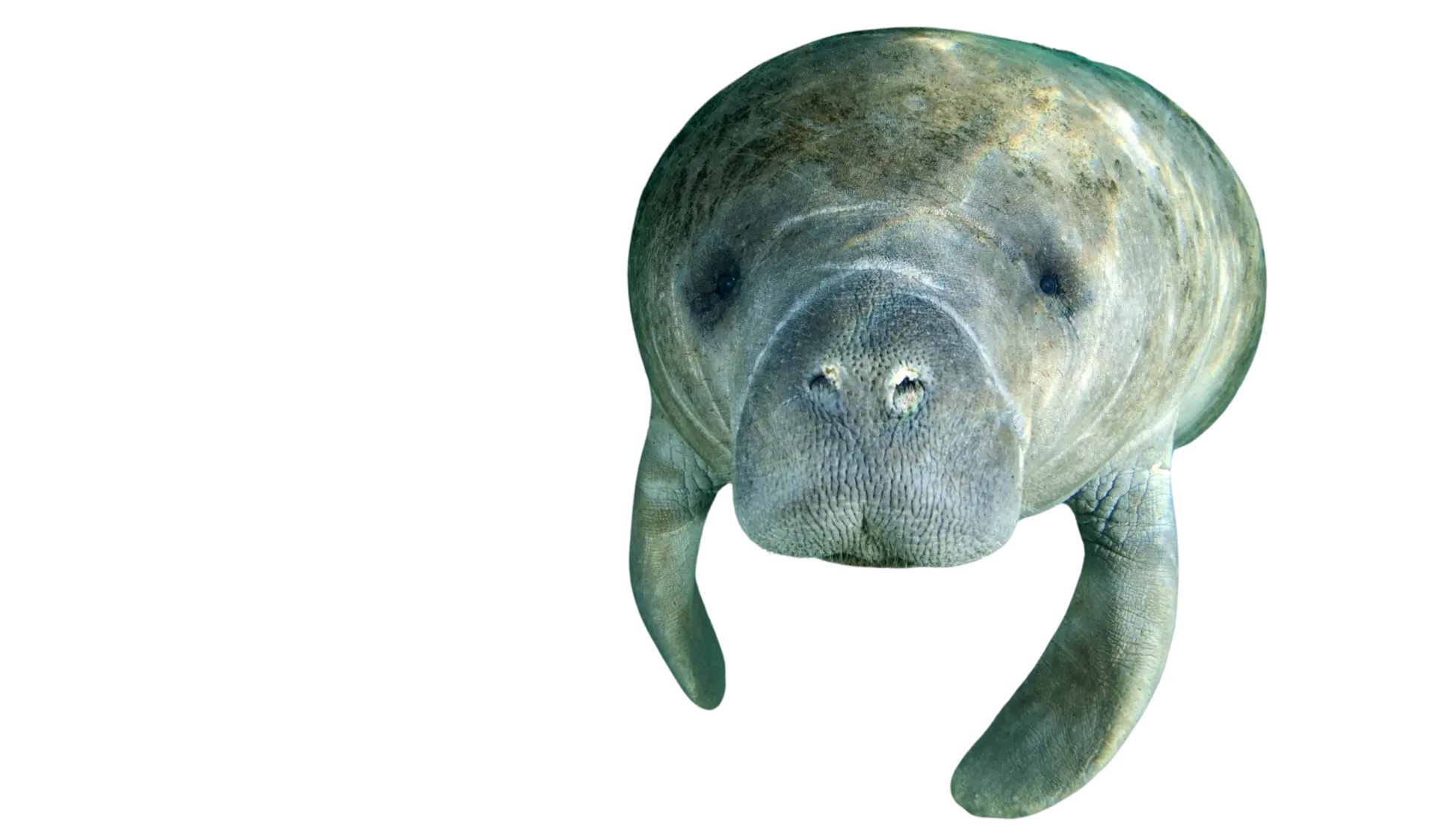The forests of Romania’s Carpathian Mountains are home to an amazing array of wildlife, including wolves, bears, lynx, and wild boar. It’s estimated that there are about 3000 wolves and around 6000 brown bears, making up one of the largest populations of wolves and bears in all of Europe. More than 25% of Romania is designated as protected, and is part of Natura 2000, the largest coordinated network of protected areas in the world.
In this wildlife corridor, you might be amazed to know that there is a thriving community of sheep herders who have lived for centuries coexisting with their local wildlife. These shepherds practice transhumance, which means they live with their flock, from April to November, after which sheep are moved to barns for winter. They build a makeshift hut, where they live right next to the pens or corrals. They manage their flocks with a special partner: livestock guardian dogs (LGD). This type of dog is bred to protect sheep from the many bears and wolves that call this region home. Shepherds here rely heavily on LGDs. But that does not mean they leave the dogs to do the job of protecting their flock. Romanian shepherds know how to deal with predators. If a bear or wolf comes near, they will jump up with the dogs. They don’t have guns, they have long staffs. And if they have to use that on a wolf or bear, you can bet they won’t be back!

Recently, we had the opportunity to talk with Paul White, a member of the IWCN Coexistence Council and an U.K. expat who has lived in Romania on and off for almost 30 years. Paul has a deep interest in wildlife and livestock farming and has documented his many observations, experiences and friendships with the shepherding community in his blog Wild Transylvania.
In his blog, Walking with Shepherds, Paul says, “ Local transhumant shepherds have taught me many valuable lessons over the years about conservation and why it’s important to work in harmony with nature. They view the mountains and forests as their bread basket, something to be nurtured and cared for, as without it they are fully aware their traditional way of life would end. They see the wolves and brown bears as part of that environment and believe that they have an equal right to be there. When sheep and goats are taken, they don’t call for predators to be culled as they expect some losses throughout the year.”

“This is the epitome of good coexistence,” says Paul. ” I know shepherds with 5-600 sheep with no loss to a predator.” The shepherds work with the dogs as a team, with the shepherd being the top dog. LGDs do not pursue the predator over long distances. Their job is to detect the immediate threat to livestock but not to kill predators. The LGDs want the wolf to see them, so they bark, growl and scratch the ground, moving around towards the threat. “Packs of wolves might be more brave when confronted with a team of LGDs than a single wolf, but a wolf knows it cannot hunt if it is injured, so they are more likely to move on if they encounter LGDs,” says Paul. “Once they do, the dogs return back to the flock.”
In Paul’s region of Romania, the shepherds work in communities. Local households have small numbers of sheep and they give the shepherds the sheep to graze from spring to autumn. The shepherds milk the sheep and make cheese right out in the meadows and sell it at local markets. And each household receives 6kg of cheese per sheep grazed in a season. The shepherd then receives payment from each villager per sheep that he has cared for when handing them back in autumn.
During his years here, Paul has befriended a young shepherd couple who speak English. Tibor and Melinda are static shepherds (not transhumance), as they choose to stay out with their flock during the winter in a caravan. Paul says they are the exception rather than the rule. Paul learned a lot about shepherd life from this couple, their two young children, and their livestock guardian dogs. Tibor and Melinda’s LGDs were not the usual Booker or Central Asian Shepherds. When Paul asked why, Tibor said he did a lot of research before he got the dogs because he wanted very specific qualities in a dog: independence, bravery and strength; but he also wanted dogs that were very friendly with people because of his children. He found those traits in the Sarplaninac, a breed that originated in Yugoslavia. Tibor had to go abroad to find a breeder for his first Sarplaninac, Bronson. Tibor said he was a ferocious beast while working, but then would come to you like a pet lap dog; friendly and fantastic with his children. Today, Tibor and Melinda have seven working dogs and puppies. He breeds them so that the older dogs can train them to be good livestock guardian dogs.

Recently, Tibor asked Paul if he would like one of the pups, named Zorro, for himself. This pup was Melinda’s favorite. Paul was delighted to bring Zorro home at 14 weeks. Zorro will not be a livestock guardian dog, but Paul is looking forward to bringing him out to the forest while he does his fieldwork. Paul sets up camera traps in the forest to track large predators in the area. The forests of Romania are rich and beautiful, but not many people walk through them for fear of bears. You have to be much more careful, carrying bear spray, a whistle and an axe. So Paul feels like it might be a good idea to have an LGD with him as he sets up camera traps. Paul says he will be the only sheep Zorro will have to protect during their outings!
These Romanian shepherds have proven for centuries that it is possible to live in harmony with the natural world and to coexist peacefully with large predators. Through Paul’s blog, Wild Transylvania, he hopes his observations help ranchers in other regions explore the ancient shepherding tactics used in Romania.

